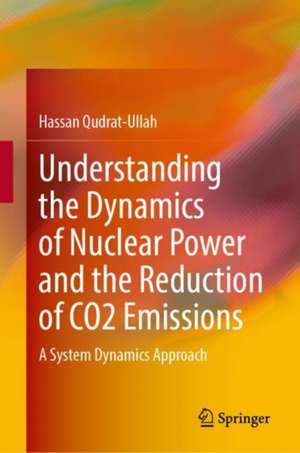Understanding the Dynamics of Nuclear Power and the Reduction of CO2 Emissions: A System Dynamics Approach
Autor Hassan Qudrat-Ullahen Limba Engleză Hardback – 15 mai 2022
The book gives an intensive review to do that comparative analysis involving China, India, Saudi Arabia, UAE, and Pakistan. The last half of the book focuses on the case in Pakistan. The author reviews Pakistan’s Intended Nationally Determined Contribution and other key sources from Pakistan’s Ministry of Energy and related institutions. Using Pakistan’s case data, the author applies the system dynamics modeling approach whereby a dynamic model, capable of representing the important interactions among various sectors of the electricity supply sector of Pakistan.
This book is intended to be of use to policymakers, managers and practitioners, teachers, researchers, and students of design and assessment of policymaking for the complex, dynamic energy systems
| Toate formatele și edițiile | Preț | Express |
|---|---|---|
| Paperback (1) | 886.47 lei 43-57 zile | |
| Springer International Publishing – 16 mai 2023 | 886.47 lei 43-57 zile | |
| Hardback (1) | 891.92 lei 43-57 zile | |
| Springer International Publishing – 15 mai 2022 | 891.92 lei 43-57 zile |
Preț: 891.92 lei
Preț vechi: 1087.72 lei
-18% Nou
Puncte Express: 1338
Preț estimativ în valută:
170.69€ • 177.55$ • 140.91£
170.69€ • 177.55$ • 140.91£
Carte tipărită la comandă
Livrare economică 14-28 aprilie
Preluare comenzi: 021 569.72.76
Specificații
ISBN-13: 9783031043406
ISBN-10: 3031043405
Pagini: 182
Ilustrații: XVI, 182 p. 56 illus., 50 illus. in color.
Dimensiuni: 155 x 235 mm
Greutate: 0.47 kg
Ediția:1st ed. 2022
Editura: Springer International Publishing
Colecția Springer
Locul publicării:Cham, Switzerland
ISBN-10: 3031043405
Pagini: 182
Ilustrații: XVI, 182 p. 56 illus., 50 illus. in color.
Dimensiuni: 155 x 235 mm
Greutate: 0.47 kg
Ediția:1st ed. 2022
Editura: Springer International Publishing
Colecția Springer
Locul publicării:Cham, Switzerland
Cuprins
Energy Policies, Mechanisms, and CO2 Emissions.- Understanding the Nature of CO2 Emissions Reduction Goal.- System Dynamic Modeling and Energy Systems.- Dynamic Modeling for Electricity-related CO2 Emissions.- CO2 Reducing Scenarios Development.- Towards a CO2 Emission-reducing Energy Policy for Pakistan.
Notă biografică
Hassan Qudrat-Ullah is a member of the Springer Complexity Board. He is Professor of Decision Sciences at the School of Administrative Studies at York University, Canada. His research interests include dynamic decision making, system dynamics modeling, and energy planning models.
Textul de pe ultima copertă
This books explains a strategy that a country can meet its CO2 emission reduction targets (e.g., as are in Paris Agreement) with a dominant share of nuclear power with a balanced energy supply mix. The book starts with an introduction to the subject of energy policy, mechanisms, and CO2 emissions, and the complexity of the CO2 reduction goal. It introduces the system dynamics approach as a solution modeling approach for dealing with the complexity of CO2 reducing policies and mechanisms. The book presents the dynamic model and its key parameters and then elaborates the structural and behavioral validity of the dynamic model.
The book gives an intensive review to do that comparative analysis involving China, India, Saudi Arabia, UAE, and Pakistan. The last half of the book focuses on the case in Pakistan. The author reviews Pakistan’s Intended Nationally Determined Contribution and other key sources from Pakistan’s Ministry of Energy and related institutions. Using Pakistan’s case data, the author applies the system dynamics modeling approach whereby a dynamic model, capable of representing the important interactions among various sectors of the electricity supply sector of Pakistan.
This book is intended to be of use to policymakers, managers and practitioners, teachers, researchers, and students of design and assessment of policymaking for the complex, dynamic energy systems
This book is intended to be of use to policymakers, managers and practitioners, teachers, researchers, and students of design and assessment of policymaking for the complex, dynamic energy systems
Caracteristici
Provides an intensive overview of CO2 emissions reducing energy policies and mechanisms
Presents a unique dynamic model representing nuclear power-based energy supply mix as a “solution model”
Evaluates and discusses socio-economic and technical dimensions of the suggested energy policy
Presents a unique dynamic model representing nuclear power-based energy supply mix as a “solution model”
Evaluates and discusses socio-economic and technical dimensions of the suggested energy policy
